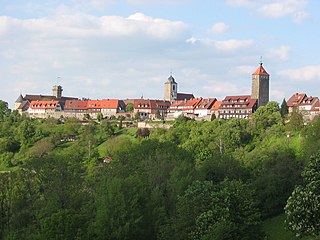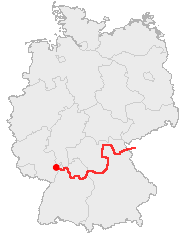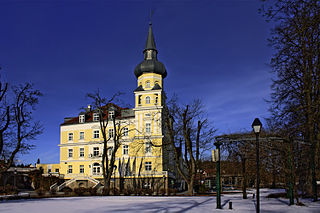
Waldenburg is a hilltop town in south central Germany, eastwards of Heilbronn in the Hohenlohe (district) of Baden-Württemberg. The town is the site of Waldenburg Castle and some hilltop churches. Records first mention Waldenburg in the year 1253, but the town was destroyed in April 1945, at the end of World War II, and it has been rebuilt since.

Hohenlohe-Waldenburg-Schillingsfürst was a County, and later Principality in northeastern Baden-Württemberg, Germany. The name Hohenlohe derives from the castle of Hohenloch near Uffenheim in Mittelfranken, which came into the possession of the descendants of Conrad of Weikersheim by 1178.

The House of Hohenlohe is a former German princely and ducal dynasty. It ruled an immediate territory within the Holy Roman Empire which was divided between several branches. In 1806 the area of Hohenlohe was 1,760 km² and its estimated population was 108,000. The motto of the house is "ex flammis orior" (english: From flames I rise). The Lords of Hohenlohe were elevated to the rank of imperial counts in 1450, and from 1744 the territory and its rulers were princely. In 1825, the German Confederation recognized the right of all members of the house to be styled Serene Highness , with the title Fürst for the heads of its branches, and princes/princesses for the other members. From 1861 the Hohenlohe-Oehringen line was also ducal and the dukes of the Duchy of Ujest.

Schillingsfürst is a municipality in the district of Ansbach, in Bavaria, Germany. It is situated 12 km southeast of Rothenburg ob der Tauber, and 23 km west of Ansbach.

The Castle Road is a theme route in southern Germany and a small portion in the Czech Republic, between Mannheim and Prague.

Kupferzell is a small German town in the district of Hohenlohe in Baden-Württemberg, Germany named after the Kupfer river flowing through it. The largest neighbouring towns are Künzelsau and Schwäbisch Hall.
Hohenlohe is a German princely family and a district in Baden-Württemberg, Germany.

Prince Alexander Leopold Franz Emmerich of Hohenlohe-Waldenburg-Schillingsfürst was a German priest and reputed miracle-worker.

Konrad Maria Eusebius Prinz zu Hohenlohe-Waldenburg-Schillingsfürst was an Austrian aristocrat and statesman. He briefly served as Prime Minister of Austria (Cisleithania) in Austria-Hungary in 1906.

Jánský Vrch is a castle located in the Jeseník District in the Olomouc Region of the Czech Republic. The castle stands on a hill above the town of Javorník in the north-western edge of Czech Silesia, in area what was a part of the Duchy of Nysa. For most of its history the castle belonged to the Prince-bishops of Breslau (Wrocław) in Silesia.

Countess Caroline von Holnstein, Baroness von Künsberg was a German noblewoman, best known for her appearance in the Gallery of Beauties.

Archduchess Maria Henrietta, full German name: Maria Henrietta Caroline Gabriele, Erzherzogin von Österreich was a member of the Teschen branch of the House of Habsburg-Lorraine and an Archduchess of Austria and Princess of Bohemia, Hungary, and Tuscany by birth. Through her marriage to Prince Gottfried Maximilian of Hohenlohe-Schillingsfürst, Maria Henrietta became a member of the house of Hohenlohe-Waldenburg-Schillingsfürst.

Margrave Charles Magnus of Baden-Durlach was a titular Margrave of Baden.
Friedrich Franz von Hohenlohe-Waldenburg-Schillingsfürst was an Austrian prince who served as a military attache in Saint Petersburg. Later he was chief of German propaganda and director of German espionage in Switzerland. He also served with his regiment on the Russian front.

Charles Albert II, Prince of Hohenlohe-Waldenburg-Schillingsfürst was the 3rd Prince of Hohenlohe-Waldenburg-Schillingsfürst from 1793 to 1796.

Charles Albert III, Prince of Hohenlohe-Waldenburg-Schillingsfürst was the 4th Prince of Hohenlohe-Waldenburg-Schillingsfürst from 1796 to 1843.

Franz Joseph Karl Conrad, Prince of Hohenlohe-Schillingsfürst was the 5th Prince of Hohenlohe-Schillingsfürst and the founder of the branch of the Dukes of Ratibor and Princes of Corvey.
Charles, Karl or Carl Albrecht may refer to:

Schwarzenfeld Castle is a historic castle in Schwarzenfeld in the district of Schwandorf in Upper Palatinate of Bavaria, Germany. It was the home of noble Holnstein family, including Count Maximilian von Holnstein, a close advisor to King Ludwig II of Bavaria.

Neuenstein Castle is a castle in the middle of the town of Neuenstein. Built as the seat of the Hohenlohe-Neuenstein noble family, it now houses a castle museum and, with the Neuenstein Hohenlohe Central Archives, the shared house archive of the House of Hohenlohe, which is looked after by the State of Baden-Württemberg.




















